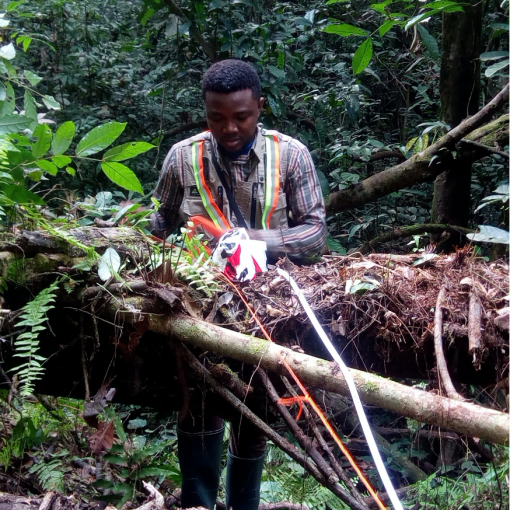Human-wildlife conflict – such as crop-raiding by elephants – is becoming a significant socioeconomic and political issue in many African countries such as Gabon. In Gabon, where my research is based, particularly at Lopé National Park, owners of small local farms are complaining of losing more and more crops due to protected forest elephant crop depredation.
Over recent decades, forest elephants seem to have increased around human settlement. This increase could be related to social pressures on natural forests, such as hunting and logging, encouraging elephants to leave their habitat, moving towards safe human settlements, or protected areas like a national park. It is the case at Lopé National Park, which is a World Heritage site.
This potential increase of forest elephants could also be related to their protection. Elephants’ presence seems to have increased in people’s farms since 1982 because hunting was prohibited as self-defense, and protected areas increase too, with 13 parks created in 2002 were established too in Gabon. These conservation actions have reinforced elephant protection by deploying eco-guards in parks and surrounding villages to monitor illegal activities. This conservation effort has placed Lopé National Park as one of the sites that might have one of the highest remaining forest elephant populations, which has just been reclassified as a critically endangered species.
Recently, the park agency has begun to manage crop depredation incidents by establishing electric fences in some villages to improve crop protection. This electric fence could also reduce the risks of losing elephants as small farmers could kill them to protect their crops (Narcisse Moukoumou. pers. comm.). Therefore, this electric fence could reduce human-elephant conflict if it allows small farmers to harvest their crops while deterring elephants from reaching those crops.
However, these electric fences did not deter elephants just after their establishment because elephant trails continued to lead to these fences. This direction of trails to the fence could suggest that elephants were still attempting to access the crops despite the threat of electrocution. Over time, trails are becoming parallel to fences indicating that elephants are abandoning to reach these protected crops. Still, instead, they appeared to head to other human settlements with unfenced farmland (Hervé R. Memiaghe and Narcisse Moukoumou field observations).
Therefore, there is a need to understand further why elephants persist in seeking crops by looking at the availability of their wild food. Recent research has suggested a relationship between the decrease of the availability of wild fruits and the reduction of forest elephant body size. Could this impact of the decline of wild fruits on their body size be another reason for the elephants’ persistence to seek crops?
Wild fruits are an important food for forest elephants. Their natural diet also includes leaves, barks, grasses, and soils, but in this diverse diet, wild fruits vary the most due to seasonal and interannual variations in fruit production. These wild fruits have become scarcer at Lopé Park and maybe at other forest sites within Gabon and on a broader scale across the range of African elephants, probably due to climate changes. This wild fruit scarcity could have already impacted forest elephants by driving the decline in their body size.
Could wild fruit scarcity be driving elephants towards farmlands around protected areas? This first report of wild fruit scarcity, which has only been demonstrated in one location in Gabon, calls for more information on the availability of wild fruit variation to guide approaches to manage forests. If wild fruit scarcity is identified as a wider issue, management solutions may seek approaches to maintain food for elephants. This integration of elephants’ needs when improving crop protection could create the condition for local farmer-elephant coexistence around protected areas by avoiding dramatic negative impacts for both farmers and forest elephants in Gabon and other countries which protect this pachyderm.
My PhD research focuses on identifying elephant needs for wild fruits throughout the forest landscape. Elephant needs should be integrated into seeking innovative land management approaches to enhance the protection of crops and local farmers’ lives and satisfy elephants. My research examines two key relationships: elephant forest use with a focus on wild fruiting trees along their trails, particularly the 20 most important tree species wild fruit availability in relation to elephant crop consumption at Lopé. These investigations could help understand the increase of elephant crop consumption and guide the design of approaches that could create conditions satisfying farmers and forest elephants in different countries, like Gabon.
I am conducting this research at Lopé National Park, where we are lucky enough to access 34 years of phenology data for a large sample of individual forest trees at SEGC (Station d’Etude des Gorilles et chimpanzes in French). I selected 20 fruiting tree species that elephants consume fruit from this phenology data. I analyze fruit availability variation from the selected sub-dataset alongside other data, such as fruiting trees located along elephant trails.
Throughout my PhD experiences, I have been very interested in collaborating and collecting the above data with this phenology data. I am keen to develop new land management approaches to protect farmers’ lands and forest elephant food needs.
Hervé Memiaghe is a Gabonese researcher. Currently, a PhD candidate working with Prof. Bart Johnson at the Department of Landscape Architecture, part of the School of Architecture and Environment in the College of Design at the University of Oregon USA. He is looking to continue improving long-term monitoring of crop depredation incidents indicators to have data that could be analyzed alongside long-term phenology data. This integration of long-term data could help better understand the relationship of wild fruits to these crop depredation incidents and implement some management methods that will satisfy local farmers and forest elephants, thereby creating the conditions for coexistence.





